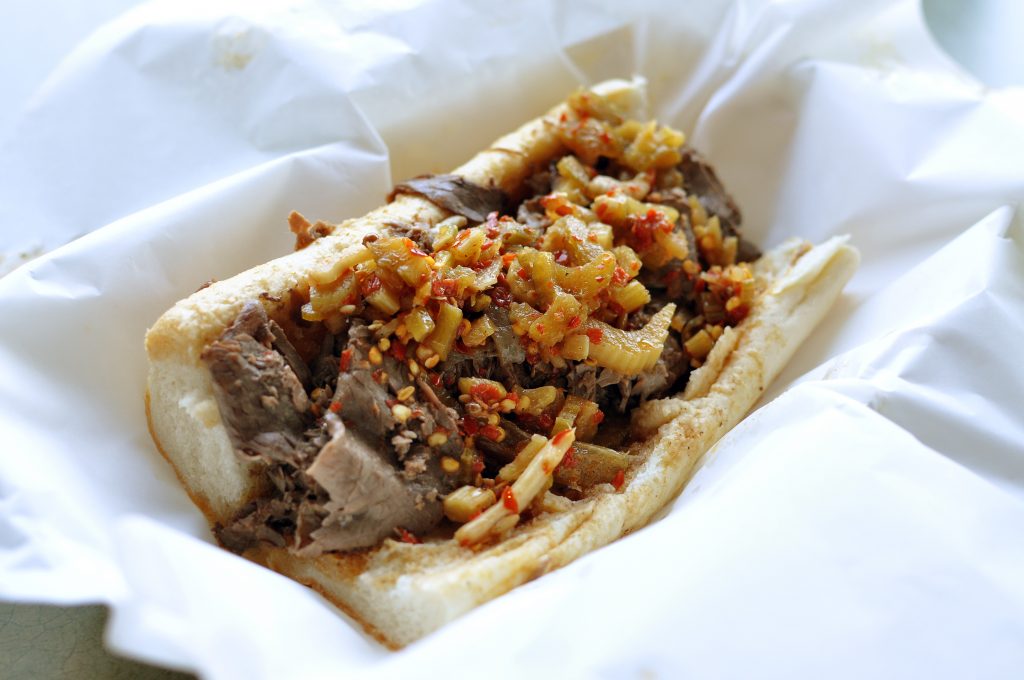This article originally appeared on MUNCHIES in April 2016.
LA County has the second highest population of Vietnamese immigrants in the US—only second to Orange County. There are around 180 places where you can get banh mi just in the San Gabriel Valley alone, including popular franchises like Lee’s Sandwiches, Mr. Baguette, and Banh Mi Che Cali.
Videos by VICE

Inside Ba Le
But none can compare to Ba Le, the El Dorado of banh mi.

BBQ pork banh mi from Ba Le
I visited Ba Le late on a recent Thursday afternoon, just as the tiny bakery was finishing up its lunch rush. Inside, a rich melange of senses hit me: pickled daikon, charred meat, boiled pork, coffee, coconut, freshly baked bread, and incense burning in a small altar underneath the front counter.

Altar at Ba Le
After ordering a BBQ pork sandwich and a pandan waffle—made with a combination of rice, wheat, and tapioca flour—I asked the cashier how long the place has been open. Unsure herself, she asked someone in the back.
“1984!” an older lady yelled in response.

Cashier at Ba Le
According to Andrea Nguyen, banh mi expert and author of The Banh Mi Handbook, the many “Ba Le Banh Mi” shops that span across America are not necessarily related. The name refers to a Chicago-based vendor, Mister Le Vo, who was the original founder of one of the first banh mi shops in the US. He sold banh mi in Saigon in the 1950s, but opened the first Ba Le bakery in 1982 in San Jose, California.

Vietnamese condiments
“Within the Viet community, the name ‘Ba Le’ has long signaled quality bread and banh mi,” Nguyen says. “People unfortunately borrowed the Ba Le name for their banh mi shops, so it can be hard to figure out which is good or legit. On the other hand, whoever takes the Ba Le name has a reputation to uphold.”

Vietnamese desserts and Cheetos
“Ba Le’s baguettes are the only ones we found that are perfectly fluffy with the just amount of proof, providing them just enough of a flaky-like crust,” says Nguyen Tran of Starry Kitchen. “No one else makes them like this and they remain to be that fucking good.” Tran swears by Ba Le’s baguettes for both his personal banh mis at home and at Button Mash, the bar-arcade in which his roving restaurant is currently located.

Refrigerated desserts
But Ba Le offers more than just expertly baked Vietnamese-French baguettes, which arrive steaming from an oven about the size of a small apartment’s bedroom. The refrigerators and shelves are stocked with coconut cream dessert drinks, a half dozen variations on pork cakes, pâtés, colorful coconut and rice-based desserts, and even Flamin’ Hot Cheetos.

As for how those pandan waffles became a thing, Nguyen isn’t sure. “It’s hard to resist pandan and green food coloring—and a waffle,” she says.

Homemade mayo and more banh mi ingredients inside Ba Le’s refrigerator
Along with my butcher-paper wrapped sandwich, I grabbed an extra container of the shop’s homemade mayonnaise to make some sandwiches later in the week.

That thick, creamy mayonnaise coats the chewy, airy baguettes like liquid gold. The homemade Vietnamese charcuterie and caramelized pork are merely vehicles to enjoy the mayonnaise and bread together.

Freshly baked baguettes
Outside, in the ever-expanding strip mall where Ba Le is located, the packed parking lot is filled with almost a perfect representation of the San Gabriel Valley’s resident demographic: a group of Asian high schoolers with boba tea and some of those Flamin’ Hots, an elderly Asian couple carrying about a dozen baguettes in their little wire pushcart, and a Latin-American young woman taking bites of her pandan waffle in the front seat of her parked Audi.
With the uptick in development in the San Gabriel Valley, there’s little room for small-time shops like Ba Le in the future. We should cherish its unflagging, DIY spirit—and its delectable mayo—while we still have the chance.



